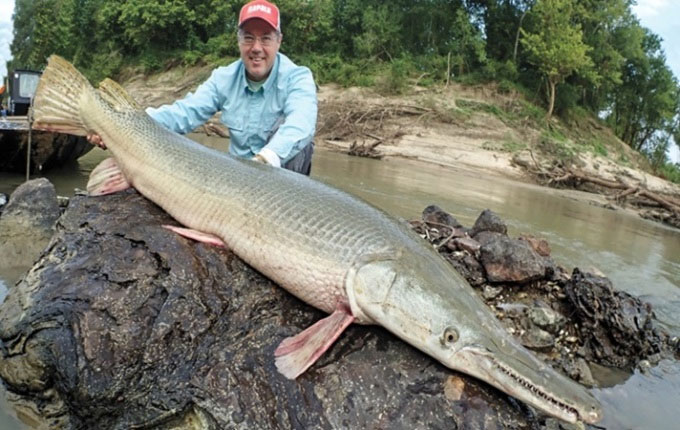'Living fossil' fish haven't evolved in 100 million years
Large gars can grow as large as crocodiles and have armor so tough it helped them survive predatory dinosaurs.
The North American giant gar ( Atractosteus spatula ) lives in rivers, reservoirs and coastal bays from the southwestern states of the United States to Veracruz, Mexico. They specialize in eating crabs, fish, birds, mammals, turtles and carrion, according to Live Science .

Giant anchovies are enormous in size. (Photo: In Fisherman).
With its long snout, thick armor-like scales and sharp teeth, this giant fish is often mistaken for a crocodile. It is the largest known member of an ancient group of ray-finned fish called gars and can grow to about 8 feet (2.4 m) in length.
The giant gar "was truly a prehistoric monster ," according to biologist Jeremy Wade on the show "River Monsters ." Fossils show they existed 100 million years ago during the Cretaceous period (66 - 145 million years ago), when dinosaurs roamed the Earth.
' Their survival is partly due to a unique defense system that includes scales made of a super-hard enamel called ganoine , ' explains Wade. ' This armor helps them survive among carnivorous dinosaurs.' The interwoven scales also protect the large gar from threats. When the gar grows to over a meter in length, its only predator is the short-snouted crocodile.
Large gar grow very quickly. They hatch as tiny, poisonous eggs, but can grow to be 2 feet long in their first year. They continue to grow throughout their lives and can live up to 100 years, says Solomon David, an aquatic ecologist at the University of Minnesota.
The giant gar is among the few 'living fossils,' species that have remained virtually unchanged for millions of years. A 2024 study found that the giant gar has the slowest rate of evolution among jawed vertebrates. They evolve so slowly that the giant gar and the alligator gar ( Lepisosteus osseus ), two species separated by 100 million years of evolution, can produce fertile hybrids . Evolution over such a long period of time often results in species that are so divergent that they can never reproduce.
Although the giant gar's sharp teeth can inflict a painful bite, they are ambush predators that feed on crabs, fish, and birds. In the 1930s, the Texas Game Fishing Commission created a device to electrocute the giant gar by firing 200 volts into the water. Today, the giant gar is protected in Florida and restricted for fishing in Texas.
- Surprising creature that can 'interbreed across 100 million years of evolution'
- The discovery of 200 million year old fossil fish in China
- Discovering fossil fish fossils 152 million years
- Biological fossil discovery 545 million years ago
- Excavating fish fossils 429 million years old
- Colombian boy goes out, finds fossil 90 million years old
- 200 million year long sea fossil remains intact
- Greedy squid led to horrific death on the sea floor 200 million years ago
- Carnivorous fish 375 million years ago
- The animal with 50 living parts 550 million years ago could decipher the secret of life
- Discover extinct fish lizards 25 years ago
- Fossil discovery of an ancient round fish
 Animal 'suffering' after hibernation
Animal 'suffering' after hibernation Why do goats climb well?
Why do goats climb well? Scientists were surprised to see chimpanzees eating turtles
Scientists were surprised to see chimpanzees eating turtles Giant catfish died deadly due to drought in Thailand
Giant catfish died deadly due to drought in Thailand